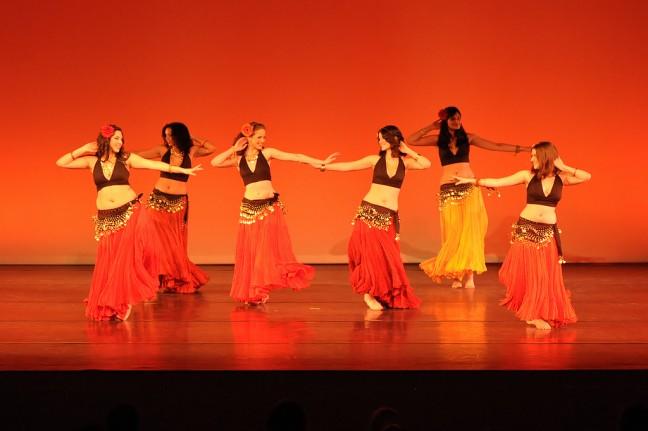The seven dancers stride confidently across the floor, brightly colored veils billowing regally behind them. They stop and twirl, once, twice, before launching into an intricately choreographed routine of sinuous hip movements and undulations.
Led by instructor Mona N’wal, the members of Bellydancing UW are in Union South practicing for a show later this April. The club, which is in its 14th year on campus, offers lessons to interested participants, as well as an opportunity to perform at one of its many community appearances.
Originating in the Middle East, bellydancing was first popularized in the United States during the Chicago World’s Fair in 1893 when traditional dancers were hired to perform. The dance style gained popularity in the U.S. as a cabaret and nightclub attraction and has remained relevant to this day.
Bellydancing is an amazingly versatile form of dancing, Bellydancing UW president Audrey Marquardt said. Although routines are traditionally performed to classical Oriental or Middle Eastern music, the club frequently choreographs routines to modern music, such as Ellie Goulding or world fusion group Beats Antique.
“A lot of bellydancing is about hitting a beat,” Marquardt said. Give them a song with a strong beat, like “Burn,” and the club members can create a bellydance routine around it.
Sharp, staccato movements like hip drops and shimmies emphasize the beat of the song when performed in time, while fluid, joint-defying undulations involving the whole body fill out slower or more rhythmic sections.
The music selection for their upcoming spring show April 12th illustrates how flexible bellydance routines can be. The playlist is composed of a surprising range of genres, with everything from classical Oriental songs to ’50s pop to the Sleigh Bells represented.
This adaptability is one of bellydancing’s greatest strengths, according to Marquardt. Not only can they perform to a wide range of music, the compositions themselves are receptive to many styles of dance. Elements of jazz, ballet and even hip-hop dancing appear in their routines.
The club members are open to incorporating other styles of dance into their routines. N’wal said she even has to occasionally hold the members back from straying too far from authentic bellydancing.
Marquardt said that the openness and inclusiveness of bellydancing are what appeal to her most. Bellydancing is body-positive, she said, due to its low impact and emphasis on controlled movements.
“It’s different than ballet where you need to be rail-thin to look good,” she said. Instead of demanding a specific kind of dancer or dance style, bellydancing draws much of its strength and appeal from including a wide range of people and styles.
Many members have dance experience in jazz or ballet, Marquardt said, and their training comes through in their dancing. “Everyone’s dance background influences how they perform,” she said. In addition, everyone finds moves and routines that appeal to them individually, she said. Personally, she prefers Mayas, fluid lateral movements of the hips that draw their name from the Egyptian word for water.
How do you go about making a bellydancing routine? Marquardt said that it all starts with the song. She begins by listening to a song over and over again “like 50 million times.” Dancers must approach a piece with an emotion or feeling, Marquardt said. “I try to put my personality into a piece,” she said.
Moves with names like hip drops, chest lifts and shoulder shimmies reveal the percussive nature of bellydancing. Performed in time with the music, the sharp movements add a visual element to the beat that elevates the impact of the music. Dancers repeat and embellish moves much like musicians use repetitive phrases in their music.
Bellydancing costumes are another way for dancers to make a statement. The traditional costume is composed of decorated tops and flowing skirts, leaving the stomach bare to show off the unique shimmies, rolls, lifts and drops that define the dance style. Flashy coins and bangles on skirts and tops add sparks of color and bright jingles to the movements. According to Marquardt, Bellydancing UW makes the majority of their costumes, adding colorful fabric, coins and decorations to tops and skirts. It is a chance for individual dancers to define their style, Marquardt said.
The skirts function both as an accessory that emphasizes spins and turns and as a means of concealing some of the “magic” behind bellydancing, Marquardt said. Many of the hip and stomach motions are actually created by moving the knees, so concealing them adds to the mesmerizing effect.
Bellydancing UW’s biggest performance is the Spring Show, going down April 12th at the Monona Terrace at 7:30 p.m. The event includes a cash bar and raffle. It also features workshops during the day and performances in the evening by the club and featured performers. This year’s headliner is Isidora Hart, an internationally recognized dancer and instructor. The show is an opportunity to showcase a broad range of bellydancing styles, Marquardt said.
The club has been hard at work preparing for the show. Marquardt said she has been practicing three or four days a week to get ready. The practice is demanding, but at Thursday practices the members smile and laugh as they perform, breaking into spontaneous dance breaks between songs. This enthusiasm for joyful movement is what unites the members of the club with each other and with bellydancers across the world.
“It just feels good,” N’wal said.








